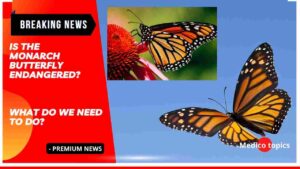
Deforestation in Mexico’s wintering forests, disturbances to their journey brought on by climate change, and the extinction of native flora along their migratory routes all pose threats to monarch butterflies. Let’s see Monarch butterfly endangered.
Is the Monarch butterfly endangered?
The migratory monarch butterfly has been listed as an endangered species due to its rapidly declining population. For millennia, it has transformed North American woodlands into kaleidoscopes of colour during one of nature’s most stunning mass migrations.
The International Union for the Conservation of Nature (IUCN) classified the migrating monarch butterfly on its “red list” of threatened species for the first time on Thursday, classifying it as “endangered” – two steps from extinction.
But as a result of temperature fluctuations, drought, and other effects of climate change, monarch butterflies and their journey are now in danger. The vulnerability of monarchs in North America is demonstrated by a long-term drop in population size both eastern and western groups.
Monarch butterfly
The monarch butterflies, the only species to perform a two-way migration, will start to migrate back to the north in the upcoming spring. Individual butterflies have a lifespan of four to five weeks, therefore it will be their offspring—likely their great-great-grandchildren—who will reach the northern states and finish this epic voyage.
Every autumn, as North American temperatures start to fall, monarch butterflies begin their annual journey to warmer, southern climates, starting as far north as Canada.
The vibrant orange and black butterflies fly up to 100 kilometres every day, gliding from asters and goldenrods to coyote bushes and rabbitbrush. They are headed south, naturally looking for the woodlands that provide the ideal overwintering conditions.
What do we need to do?
The amazing fall migration of monarch butterflies from southern Canada to central Mexico is actually reliant on sugars (energy) produced primarily by late-flowering asters and goldenrod species.
Without this amazing timing, the monarchs wouldn’t have an energy source to make that spectacular long-distance migration.
You may assist monarch butterflies by:
Develop milkweed:
- Asclepias syriaca, sometimes known as common milkweed, thrives in well-drained soil.
- Asclepias tuberosa, sometimes known as butterfly milkweed, thrives in well-drained soil.
- Asclepias incarnata, often known as swamp milkweed, thrives in moister environments as well as in typical gardens.
Plant native species that bloom later:
- Pale purple coneflower (Echinacea pallida)
- Black-eyed Susan (Rudbeckia hirta)
- Asters (e.g., New England aster, Symphyotrichum novae-angliae)
- Goldenrods (e.g., Canada goldenrod, Solidago canadensis)
Why should we save Monarch Butterfly?
The monarch butterfly migration across the continent serves a vital function as pollinators, which is necessary for many ecosystems to flourish.
Humans have many of the flowers and food staples that we adore, including squash and blueberries, because of pollinators like butterflies, bees, and other insects.
Another crucial function played by monarchs in North America is that of a cultural figure.
KEEP READING,
How did Justin Crawford die? What happened? Cause of death.
Who killed the 14-year-old girl in Mount Vernon, Maine? REVEALED
Follow us on Twitter to get instant notifications on the latest news.
News content writer.

2 thoughts on “Is the Monarch butterfly endangered? What do we need to do?”